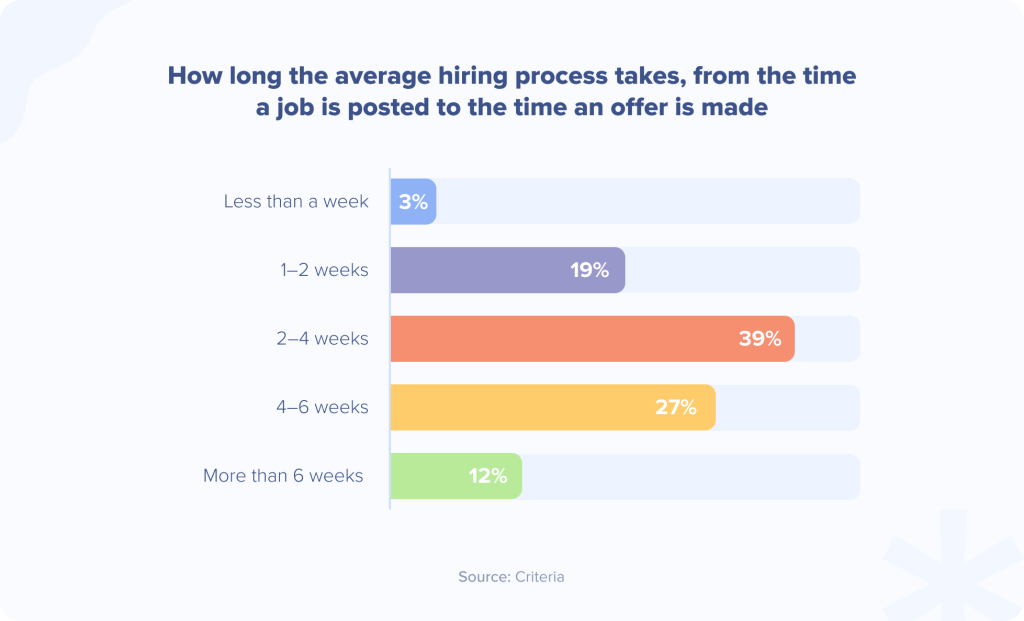
Subscribe for updates
Get talent acquisition best practices, trends, and news delivered directly to your inbox.
By entering your email, you agree to receive marketing emails from JobScore
Recruiting skilled talent involves significant time, effort, and resources. From crafting compelling job descriptions to conducting multiple rounds of interviews, your team invests heavily in finding those perfect candidates. After all this work, you want your top choice candidates to accept your offers.
A high job offer acceptance rate can help you improve both your quality of hire and time to fill, so you can build a more efficient and effective hiring process.
What is your job offer acceptance rate?
Job offer acceptance rate measures the percentage of candidates who accept your formal job offers.
It’s a straightforward calculation: divide the number of accepted offers by the total number of offers extended during a specific period, then multiply by 100 to get your percentage. For example, if you extended 20 job offers last quarter and 15 candidates accepted, your acceptance rate would be 75%.

This seemingly simple metric provides powerful insights into your company’s ability to engage talent so you can identify opportunities for improvement. That’s why this is one of the most commonly measured talent acquisition metrics, behind only quality of hire and time to hire.
Why tracking your job offer acceptance rate matters
Declined job offers happen at every company. There’s no need to dwell on them, though measuring candidate withdrawals can be instrumental in helping you improve your hiring process.
Identify patterns
Changes in your job offer acceptance rate can help you identify the factors that impact candidate decision making. For example, you might find that your offer acceptance rate increases with more employer branding materials, but decreases when you add an extra step to your interview process. This data can help you make more informed decisions.
Competitive positioning
Your offer acceptance rate reflects how appealing your company is compared to your competitors. A high rate suggests you’re offering what candidates want; a low rate indicates areas in need of improvement. Monitoring this metric helps you gain insights into your market position so you can adjust your approach accordingly.
Process evaluation
Tracking acceptance rates helps identify weaknesses in your hiring process. Are candidates dropping out after learning about compensation? Are they getting better offers elsewhere? Understanding these patterns allows for targeted improvements rather than guesswork.
Forecasting ability
Reliable offer acceptance rate data improves your candidate pipelining process. If you know that about 75% of your offers are accepted, you can better plan how many candidates to source and interview to fill a position. These insights can make your hiring more efficient and predictable.
Benefits of increasing your job offer acceptance rate
Improving your acceptance rate delivers multiple advantages that extend beyond simply filling positions:
Reduced recruiting costs
Each declined offer means additional expenses in sourcing, screening, and interviewing new candidates. Improving your offer acceptance rate can help you decrease your overall cost of hire.
Shorter time to fill
Positions remain vacant longer when offers are declined, affecting team productivity and morale. A higher acceptance rate means faster placement of new team members, maintaining workflow continuity and reducing strain on existing team members.
Higher quality hires
Your top choice candidates likely have most — if not all — of the qualifications you want in new team members. Hiring more of them can elevate your quality of hire.
Plus, you attract higher quality candidates when your organization becomes known for positive hiring experiences and competitive offers. This creates a virtuous cycle where better candidates lead to stronger teams, enhancing your employer brand and attracting even more top talent.
Team productivity
Quick, successful hiring maintains productivity. Current team members often shoulder additional responsibilities when positions stay open due to declined offers, potentially leading to burnout and decreased output. Efficient hiring through higher acceptance rates preserves team energy and focus.
Stronger employer brand
Your acceptance rate influences how candidates perceive your company in the job market.
Candidates who have a poor experience and decline your offer may share their feedback on public channels, hurting your employer brand. But taking steps to encourage more candidates to accept your offers can lead to happier candidates and employees — and a more positive employer brand.
How to improve your job offer acceptance rate
Improving offer acceptance rates was a top priority for employers last year, and 31% of employers continue to prioritize it this year. This requires a holistic approach that addresses various aspects of the candidate experience.
Streamline your hiring process
A long, cumbersome recruitment process gives your competitors time to extend candidate offers before you do. In fact, 32% of candidates that withdrew from the recruiting process said they accepted another offer from a different company.
Create a clear, efficient process with these elements:
Candidates appreciate transparency and efficiency. The faster you can move from interview to offer, the less likely they’ll accept positions elsewhere before receiving yours.

Craft competitive compensation packages
A quarter of talent professionals have faced challenges around candidates receiving multiple offers. Make sure yours is competitive so it doesn’t work against you.
Review your compensation packages regularly and keep in mind that compensation extends beyond base pay. Ensure your pay bands and benefits are competitive within your market while highlighting unique perks that other companies might not offer. For example, share information during the job offer stage about bonuses, health insurance, retirement plans, and perks like gym memberships or wellness programs.
More than half of candidates (61%) prioritize compensation and benefits when considering a new job — though it’s certainly not the only consideration. Other top priorities include work-life balance, flexible work, and job security.
Enhance your employer brand
Your company’s reputation significantly influences acceptance decisions. Candidates research your company thoroughly, checking review sites and social media before making decisions.
Strengthen your employer brand by:
Improve the candidate experience
The hiring process shapes candidates’ perceptions of your company. In fact, 52% of candidates would refuse an otherwise attractive job offer if they had a negative experience during the recruitment process. And 70% of candidates with multiple offers would consider the smoothness of their recruitment process to be a key factor when making their decision.
Create positive experiences by:
Communicate your growth opportunities
Candidates want to know they’ll have paths for advancement. Even if you don’t have traditional corporate ladders, share how your candidate could grow within your team.
Clearly articulate:
Transparency about growth potential helps candidates see long-term value beyond the initial offer.
Personalize your job offers
Generic offers feel transactional. Knowing what motivates each candidate makes it possible to tailor your offer, making it more appealing and increasing acceptance likelihood. It also provides important context to address counteroffers.
Personalization strategies include:
The personal touch shows candidates they’re valued as individuals.
Expedite the offer process
Once you decide on a candidate, move quickly. Most candidates (61%) say they receive an offer within one week after the final interview.
Streamline your offer process by:
The best candidates won’t be available for long. Speed without sacrificing thoroughness demonstrates your efficiency and eagerness to bring the candidate aboard.
Present offers effectively
The way you present an offer influences the likelihood of acceptance.
Effective presentation includes:
This approach demonstrates professionalism and personal investment in the candidate’s decision.
Gather and act on feedback
Continuous improvement requires understanding why candidates accept or decline your offers. Create simple candidate surveys for both outcomes to gather actionable insights.
Ask declined candidates:
Ask accepted candidates:
Use this feedback to refine your approach and address common concerns proactively.
Final thoughts on job offer acceptance rate
Improving your acceptance rate isn’t about quick fixes — it’s about creating a candidate-centered approach that reflects your company’s values and culture. When candidates experience these values throughout the hiring process, saying “yes” becomes the natural next step in their journey with your organization.
Monitoring and improving your job offer acceptance rate requires organization, data, and consistent follow-through. This is where a modern applicant tracking system can become invaluable.
An effective ATS can help you track offer acceptance rates and measure improvements over time. It can also help you provide a smoother candidate journey that encourages more skilled job seekers to accept your job offer. The right technology will enable you to build a more efficient, effective hiring process that secures top talent while reducing costs and time to fill. Learn how JobScore can help.



